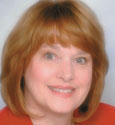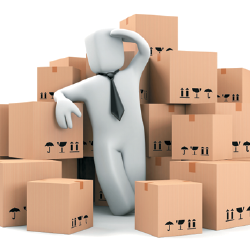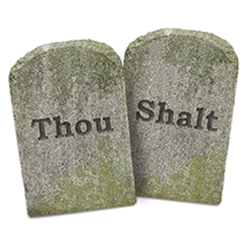 |
 Candy Adams,
Candy Adams,
CTSM, CME,
CEM, CMP, CMM,
is an independent exhibit-management
consultant, trainer, speaker, writer, and an Exhibitor conference
faculty member.
CandyAdams
@BoothMom.com
|
| |
 was shocked the first time I saw a fire marshal hold a Bic lighter to a hidden portion of my exhibit to test the fire-resistance of some suspiciouslooking exhibit material. Thankfully, the material passed the test by melting, but not bursting into flames or smoking.
was shocked the first time I saw a fire marshal hold a Bic lighter to a hidden portion of my exhibit to test the fire-resistance of some suspiciouslooking exhibit material. Thankfully, the material passed the test by melting, but not bursting into flames or smoking.
Despite the hassle of being busted on the show floor for fire violations, fire marshals are one of our greatest allies on the show floor. They exist to keep exhibitors, attendees, contractors, show labor, and convention-center staff from becoming crispy critters. Laws give broad discretionary power to fire marshals, with good reason: There have been fires in major public show venues and hotels in Chicago, Las Vegas, and most recently Detroit. In 1967, the seven-year-old McCormick Place in Chicago was destroyed by fire the night before The National Housewares Manufacturers Association show, blamed on sub-standard electrical wiring in an exhibit. Fire marshals enforce local, state, and federal fire regulations in public venues throughout the United States. All materials used in the exhibit area must conform to local fire ordinances and meet standards established by the National Association of Fire Underwriters. The industry fire standards are published by the National Fire Protection Association (NFPA; www.nfpa.org), the authority on fire, electrical, and building safety, and are often referenced within the convention center's published guidelines. Depending on local rules and the fire-suppression system installed in the public venue, the specific regulations will vary.
Over the course of 19 years and close to 400 trade shows, I've personally experienced five different fires, the first one at my very first show. Three were caused by halogen lights, one by an overheating computer, and one by a van-line trailer unloading on the show floor when its brakes overheated. Luckily, no one was hurt in any of these small mishaps.
But I've learned some very important lessons from these close calls and from talking with fire marshals at various convention centers. The following information should provide some clarity with regard to fire safety and fire regulations as they apply to the trade show floor. Hopefully that clarity will keep you and your exhibit from going up in smoke at your next show.
Exhibit Materials
Before you head off to Home Depot and buy the materials to build your own exhibit, research the fire marshal's restrictions on exhibit materials for your show. When in doubt, call the fire marshal directly and ask.
All materials used in your exhibit must be either flame resistive, flame resistant, or flame retardant. Although these may all sound like the same thing, each has a specific definition. Fire/flame resistive is the highest level of protection, and refers to materials that do not burn or support combustion. Flame resistant is the second level of protection, and refers materials that by design, composition, or inherent non-combustible design do not support a flame from an outside heat source; they self-extinguish. Fire retardant is the third and lowest level of protection, and refers to materials that have been treated with a non-combustible substance to make them fire resistant. Fire-retardant substances can be added to the material during manufacturing, added commercially after manufacturing, or applied in the field by trained professionals.
The terms "fireproof" and "flameproof" are considered inappropriate and misleading. As Robert Marihugh, the retired fire chief from my hometown of Defiance, OH, and now an arson investigator, told me, "The only thing that is 'fireproof' is the boss' son!"
In addition to the requirement that all materials be flame resistive, flame resistant, or flame retardant, there are additional requirements for specific materials often used in exhibit construction. If your exhibit - or any part of your exhibit - fails to meet code, it may be ordered dismantled and removed from the show floor.
This rarely happens, as the fire marshals will work with you to solve the problem if at all possible. But proactively understanding the regulations and making sure your exhibit and its materials meet those requirements will save you an inordinate amount of time and stress, and help ensure a successful show for you and
your company. Here are the general guidelines for wood, carpet, and fabric:
Wood: The NFPA Standard 703 states, "Wood shall be greater than one-fourth inch nominal thickness or wood not greater than one-fourth inch thickness shall be treated, fire retardant wood."
Carpet: Commercial carpet is classified by testing laboratories that use a nationally recognized standard for combustibility. Class 1 or A carpets offer the highest level of fire protection while Class 3 or C carpets offer the lowest. Nonrated, residential carpet is banned from use in public buildings. Even the adhesive doublesided tape used to secure the carpet to the floor should be the same or better rating than that of the carpet.
Fabric: All materials must be either made of non-combustible materials or treated with a flame retardant. See NFPA 701 for textiles and films, and Underwriters Laboratories 1975 for foamed plastics.
Covered and Double-Deck Exhibits
Building an enclosed double-deck exhibit in a convention hall is literally constructing a building inside a building. To make sure that both buildings are as safe as possible from fire, you may have to take extra measures.
Depending on the individual convention center, exhibitors may be required to put either approved smoke detectors with audible alarms or full sprinkler systems in exhibits with covered areas, where a covering would prevent the building's sprinkler system from discharging water unobstructed to the floor.
If you are planning on using either multi-level exhibits or exhibits with enclosed areas, your best bet is to contact the convention center's fire marshal and his or her counterpart, the structural engineer, to determine the specific rules and regulations as soon as you start planning your exhibit. The fire marshal will generally request a copy of your exhibit plan for approval. Depending on the city and convention center, there may be a charge for reviewing and (hopefully) approving your design.
While it is rare, I have seen fire marshals cordon off entire double-deck exhibits that don't meet code. That means no one - attendees or staffers - is allowed inside the exhibit. Having a clear understanding of the regulations that apply to the show venue, and having written approval of your exhibit plan is essential if you hope to exhibit in a double-deck without fear of breaching fire-safety regulations.
Exhibit Lighting
Halogen lighting can overheat and has been the culprit in three of my exhibit fires. In one case, large halogens used to up-light a product pedestal overheated computer cables until they started smoldering. In the second case, the adjustable pivots that held our halogen stem lights didn't hold and caused the lamps to fall against a foam-core graphic, bubbling and singeing it. At a third show, a halogen stem light exploded, and the shards of glass that landed on the floor were hot enough to actually melt our booth carpet.
As of 2003, the Las Vegas Convention Center (LVCC) has banned the used of 100-watt quartz halogen light fixtures with a linear quartz bulb or non-shielded halogen bulb, due to a half-dozen incidents of exploding lights in the year before the ban. (Since the ban, there have been no similar incidents.) Its research found that halogen bulbs are routinely handled with bare hands, which leave a residue of body oil that creates hot spots that then can cause the bulbs to overheat and explode. Exhibitors are still allowed to use 75-watt sealed halogen bulbs at the LVCC. Complete LVCC regulations on this restriction, along with a list of light bulbs that are still allowed, can be found online at www.ExhibitorOnline.com.
But before going out and replacing all of your halogen fixtures, be sure to check the specific regulations at your show venue, as they may still allow halogen bulbs. For example, across town at the Mandalay Bay Convention Center in Las Vegas, the lights banned at LVCC are permitted - based on the difference of Clark County vs. Las Vegas City fire regulations.
Electrical Standards
Electrical installations must conform with the Uniform Building Code and the National Electric Code. All electrical equipment must be Underwriter's Laboratory (UL) approved, all extension cords must have grounded plugs (three-wire UL approved), and only multi-plug adapters with built-in overload protection (circuit interrupters aka surge protectors) are allowed. Cube taps, which convert one electrical socket into three to six sockets, are prohibited. Furthermore, most convention centers only allow flat extension cords that use a minimum of 14-gauge wire.
Electrical work under exhibit carpeting must be done or supervised by the general service contractor's designated electrical contractor. In most venues, hard-wall exhibits must be a minimum of 9 inches from the rear booth line for access to electrical wiring running behind it. If your display involves water, you may be required to protect the equipment with a ground fault interrupter (GFI) device to prevent any electrical shock.
But proper wiring does not ensure your electrical equipment is completely safe from harm. Another of my small exhibit fires was caused by lack of ventilation for computer equipment in an enclosed kiosk. You're probably familiar with that hot, acrid smell of electrical wiring overheating. That smell was the first clue that we had a problem, before the equipment actually caught on fire. To avoid that red-hot nightmare, work with your exhibit house to make sure you have adequate air flow around any enclosed electrical equipment.
Vehicles on the Show Floor
If you're planning on bringing a vehicle into your exhibit to display, plan on having a low volume of gasoline in the tank. Depending on the venue, this volume of gasoline can be one-eighth to one-quarter of a tank or a maximum of 5 gallons. You will also have to disconnect both battery cables and possibly tape the battery ends, lock or seal the fuel tank opening to prevent the escape of vapors and avoid tampering, and turn the keys to the vehicle(s) over to the GSC's material-handling staff, where they must be kept in a common accessible location for removal from the convention center in the event of an emergency.
The vehicle will need to be driven to your exhibit space on the show floor by authorized (usually teamster) personnel. And don't be surprised if you are also told to provide and place a larger-than-normal fire extinguisher near the vehicle.
Exits and Exit Signs
Exhibits can't obstruct either exit doors or the view of exit signs. They also can't obstruct fire hose or fire apparatus cabinets, fire-alarm pull stations, or sprinkler closets; these must be visible and accessible at all times. Depending on the venue, a clearance of 3 to 10 feet must be left unobstructed between fire apparatus and your exhibit properties.
Also, if the crowd gathering around your exhibit overflows and blocks the show aisles, don't be surprised to get a visit from the fire marshal, since maintaining open aisles and access to egress from the building are also part of the fire marshal's job.
Literature Storage
Since exhibitors' collateral literature is generally flammable, most fire marshals limit exhibitors to a one-day supply of literature with no storage of cardboard boxes within their exhibit space. Others take it a step further and state that they will physically remove excess literature and store it at the exhibitors' expense. Check with your GSC on the availability of accessible storage to store additional collateral literature. If you're unable to locate suitable storage, you may be able to simply store the extra literature in your hotel room and replenish the in-booth supply when you arrive at the convention center each morning.
Although many exhibiting rules are typically bendable on a casebycase basis, fire safety is not something to mess around with. And while this article covers some of the basic, most common fire regulations, it is by no means a replacement for reading - and re-reading - the guidelines and restrictions specific to your show and its venue in the exhibitor services manual. Knowing those fire-related safety regulations and carefully following the instructions of your fire marshal is the best way to make sure your plans are foolproof - and almost as fireproof as the boss' son.
e
|





 was shocked the first time I saw a fire marshal hold a Bic lighter to a hidden portion of my exhibit to test the fire-resistance of some suspiciouslooking exhibit material. Thankfully, the material passed the test by melting, but not bursting into flames or smoking.
was shocked the first time I saw a fire marshal hold a Bic lighter to a hidden portion of my exhibit to test the fire-resistance of some suspiciouslooking exhibit material. Thankfully, the material passed the test by melting, but not bursting into flames or smoking.


